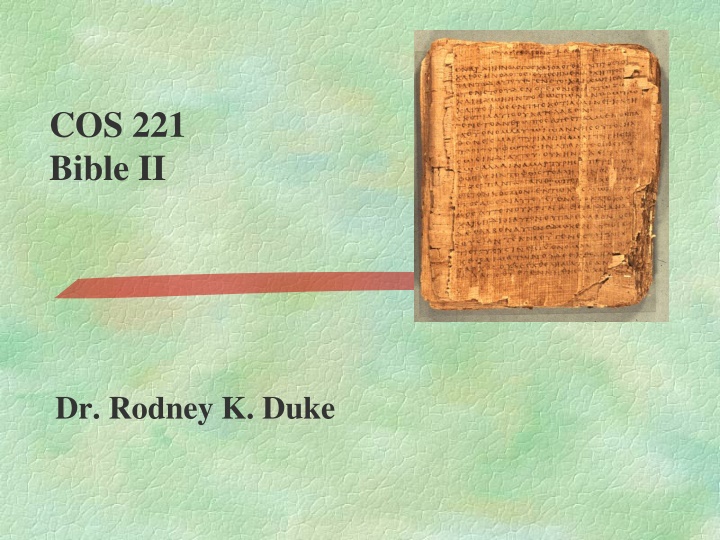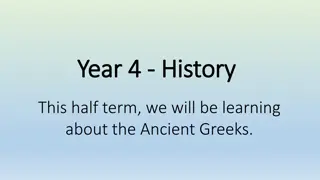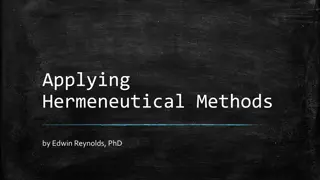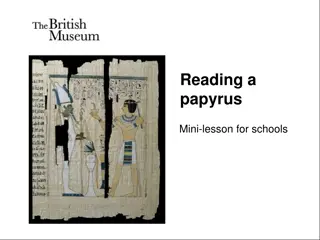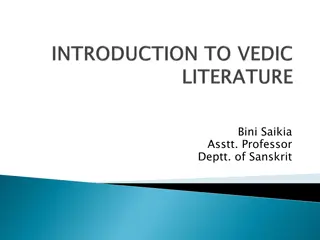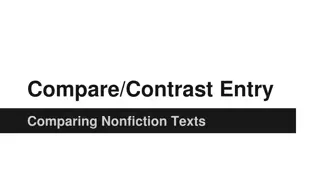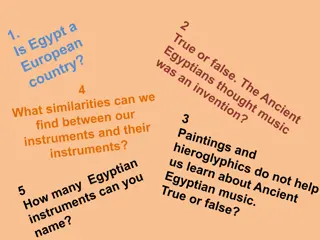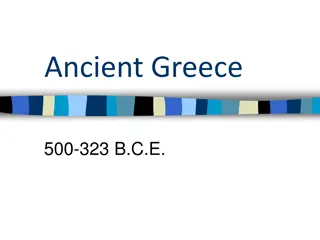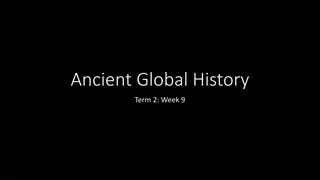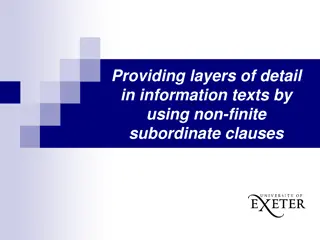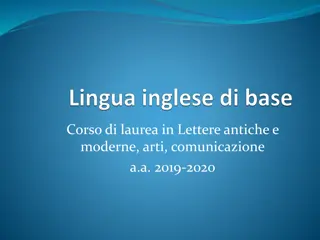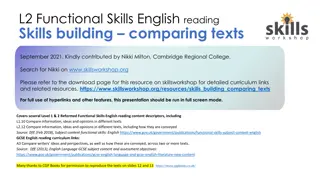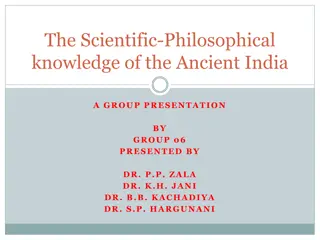Ancient Creation Texts
Texts like Enuma Elish and Memphite Theology not only describe the origins of the cosmos and gods but also serve as political treatises. They reflect ancient beliefs and rituals, influencing state religion and social structures. Understanding these narratives helps in deciphering the roles of gods and the natural order of the world as perceived by ancient civilizations.
Download Presentation

Please find below an Image/Link to download the presentation.
The content on the website is provided AS IS for your information and personal use only. It may not be sold, licensed, or shared on other websites without obtaining consent from the author.If you encounter any issues during the download, it is possible that the publisher has removed the file from their server.
You are allowed to download the files provided on this website for personal or commercial use, subject to the condition that they are used lawfully. All files are the property of their respective owners.
The content on the website is provided AS IS for your information and personal use only. It may not be sold, licensed, or shared on other websites without obtaining consent from the author.
E N D
Presentation Transcript
COS 221 Bible II Dr. Rodney K. Duke
DAY 4 Assign: 1) (Journal) 2) #12 Deuteronomistic History *Change W to N (notes) 3) #14 Priesthood *Change W to N (notes) 4) #15 Chronicles *Change W to N (notes) 5) #16 Ruth Just if you want to for fun. Day Obj.: (Laws, Cult) 1) Describe how narratives communicate meaning. 2) Formulate guidelines for reading biblical narrative. 3) Formulate guidelines for readingand applying OT laws. 4) Describe the Deuteronomistic History.
Reading Ancient Creation Texts in Context Some of the texts (e.g. Enuma Elish, Memphite Theology) are not merely abstract cosmogonies (origin of the cosmos) or theogonies (origins of the gods), but political treatises. Established state religion, capital city, main temple, ruler Egyptian accounts of Heliopolis, Hermopolis, and Thebes, each identifies the primordial land with their cultic center. Established social structure/roles/archetypes of tradition Some of the texts may have been used in religious ritual re- enactments (mimetic magic) of the state religion s myths in order to encourage the god to carry out their proper functions in maintaining the natural order of the world Enuma Elish became used in the New Year Festival. Pyramid Texts, king (as image of) ritually stands in for Atum (Kheprer) when he assumed kingship of the world he was creating. Egyptian Re-Atum renews world every day.
Those texts which present a cosmogony and/or theogony, even if politically oriented: Explain the nature of things and how they came to be the way they are. Are focused not on material origins, but on the origins of the functions and roles of the gods as reflected in the physical world. Presupposes their ancient phenomenological (commonly observed) understanding of the cosmos. (See following slide on Issue of Science and the Bible )
Parallels Between Genesis 1-2 and Enuma Elish Parallel Genesis Enuma Elish Chaos from the absence of gods and the absence of name EE I. lines 7- 8). Chaotic Primeval State Formless and empty Gen 1:2a Darkness over the surface of the watery depths Gen 1:2b, and separation of two spheres of water (cf. Gen 1:6-7) Tiamat, personification of primeval ocean, split in two spheres of water EE IV. lines 100-140. Primordial Waters Mankind is created from the blood of Kingu, Tiamat s co-conspirator EE VI. lines 1-10. Creation of Mankind Man is formed out of dust Gen 2:7 Mankind is created in the image of God Gen 1:26-27; cf. Gen 5:3, where the divine image given to Adam is carried on to his progeny (i.e., Seth). Anu begets Nudimmud in his image EE I. line 16. *Note: Both Anu and Nudimmud, however, are both gods, not humans. Image Marduk and other gods take rest in temple after victory over creation- conflict EE V. lines 121-130; cf. VI. lines 51-60. Yahweh takes up divine rest in his cosmic-temple after creation out of chaos (cf. Gen 3:8; Rev 22:1-2) Temple-Rest http://atpreston.wordpress.com/2012/11/05/a-comparative-essay-on-the-creation-epic-of-enuma-elish-and-genesis-1-2/
http://biologos.org/blog/the-second- creation-story-and-atrahasis
General Similarities Between Genesis Texts and ANE Same basic story outlines and emplotment. Same kinds of literary features. Neither focused on material origins, but on nature of life now. ANE texts explain the functional roles of the gods involved in maintaining the order of the world Hebrew explain how God established the proper functioning of the cosmos. Difference: God is NOT a part of the material world; God is NOT a functionary in it as other gods; God is sovereign over all. Both concerned about understanding order and chaos ANE gods want to establish equilibrium and rest: after victory, they establish sacred city/temple Hebrew: God creates cosmos as Temple of order, equilibrium, unending 7th day of rest. Sabbath (7 day dedication)
General Differences Between Genesis Texts and ANE Political: Not establishing a capital city, temple, or a king/pharaoh All land is the same [Note: no concept of planet earth ] Not establishing a separate state religion Worship of Israelite God was apparently both state and popular religion Not establishing a divided social order with king as son (Egypt) or regent (Mesopotamia) All humans are created in the image of God (image not a statue of a god or king) Not establishing a labor class from other All serve with/for God In Gen. 2, monogenesis, not polygenesis: Adam and Eve as archetypes who ideally walk and talk with Yahweh.
General Differences Cont. Theological/Religious No theogony (birth of gods) Monotheistic: God assumes all functions of the cosmos No battle among gods (Mesopotamia) God is sovereign over chaos and all that is contra life No pantheism or animism (material world as manifestation of gods or spirits) God is not part of natural world No mythic enactment and mimetic magic God, not materially part of world, cannot be coerced No common folk Humans have lofty calling: all in image of God (Gen 1) all given priestly role of serving (Gen 2)
Issues of Interpretation Physical Picture The origin texts of the ancient Near East, including the Bible, have to be read and understood on the basis of their ancient understanding of the physical world ( world picture ), NOT on the perspective of some later era, 18th century, 21st century, or future 22nd century. Helpful distinction? World picture (a scientific and pragmatic explanation of reality) is culturally dependent and ever changing. Worldview (a religious meaning/value-oriented understanding of reality) might be viewed as lasting. Function of ANE Origin Texts Such narrative texts presented a basic worldview (divine, human, and natural realms), explaining, in part politically, why things are the way they are.
BIBLE AS HISTORY Overview of Issues 1. Nature of the Bible: The Bible is not a history book but a collection of many genres: wisdom, prophetic, legal, hymnic, apocalyptic, etc., as well as historical narrative. 2. Literary issues: How do we know a historical narrative when we see it? What distinguishes it from fiction? Are there blends (types of literature that blend history and fiction)? What should we expect from ancient Near Eastern historical narrative? How does it differ from modern Western history telling?
BIBLE AS HISTORY 3. Functional issue: What are the communicative purposes of telling history in general? What were the Israelite (OT) and Christian (NT) purposes? [Different genre have different functions.] 4. Issue of historicity: How accurate are the biblical historical narratives? [Note: accuracy depends on the function/communicative purposes (#3) and standard necessary to carry out that function.]
BIBLE AS HISTORY 5. Nature of Inspiration: Does the literature in the Bible carry out God s communicative purposes? Not: 21st century expectations of being able to determine the authorship, date of writing, unity of writing, etc. Question: Could God work through the community of faith over several generations to preserve, shape, and edit the biblical text AND it still be inspired for God s communicative purposes?
Literary Issues: What should we expect from ancient Near Eastern historical narrative versus modern? Hebrew historical narrative combines: historiography ( Something like this must have happened ), science (Rational explanation of cosmology from a phenomenological perspective. Modern science has this same mythic function of explaining origins materially. theology (The character and involvement of God), and aesthetics (Well composed poetically ).
[Duke] Propositional Truth Vs. Mimetic Truth (Thinking in terms of historical referentiality) Language Asks if textual world is accurate to real world historically (events in time & space) creates Referential Quality Textual World How does it relate? Mimetic Asks if textual world is accurate to nature of real world in terms of how life works (life s experiences)* Quality Real World [Note: One might call both qualities referential, but pointing to two different considerations: historically unique and/or nature of reality.] *Can there be interpretation (application), if there is no mimetic quality?
Literary Issues: What should we expect from ancient Near Eastern historical narrative versus modern? Modern Modern Ancient Ancient Theistic perspective vs. Atheistic perspective Aesthetically crafted vs. Plain objective style Phenomenological view vs. Scientific world view Functional embellishment vs. Nothing but the facts Creation of speeches for character portrayal vs. Word-for-word accuracy Orally transmitted texts drop incidental details etc. vs. Focus on incidental details
